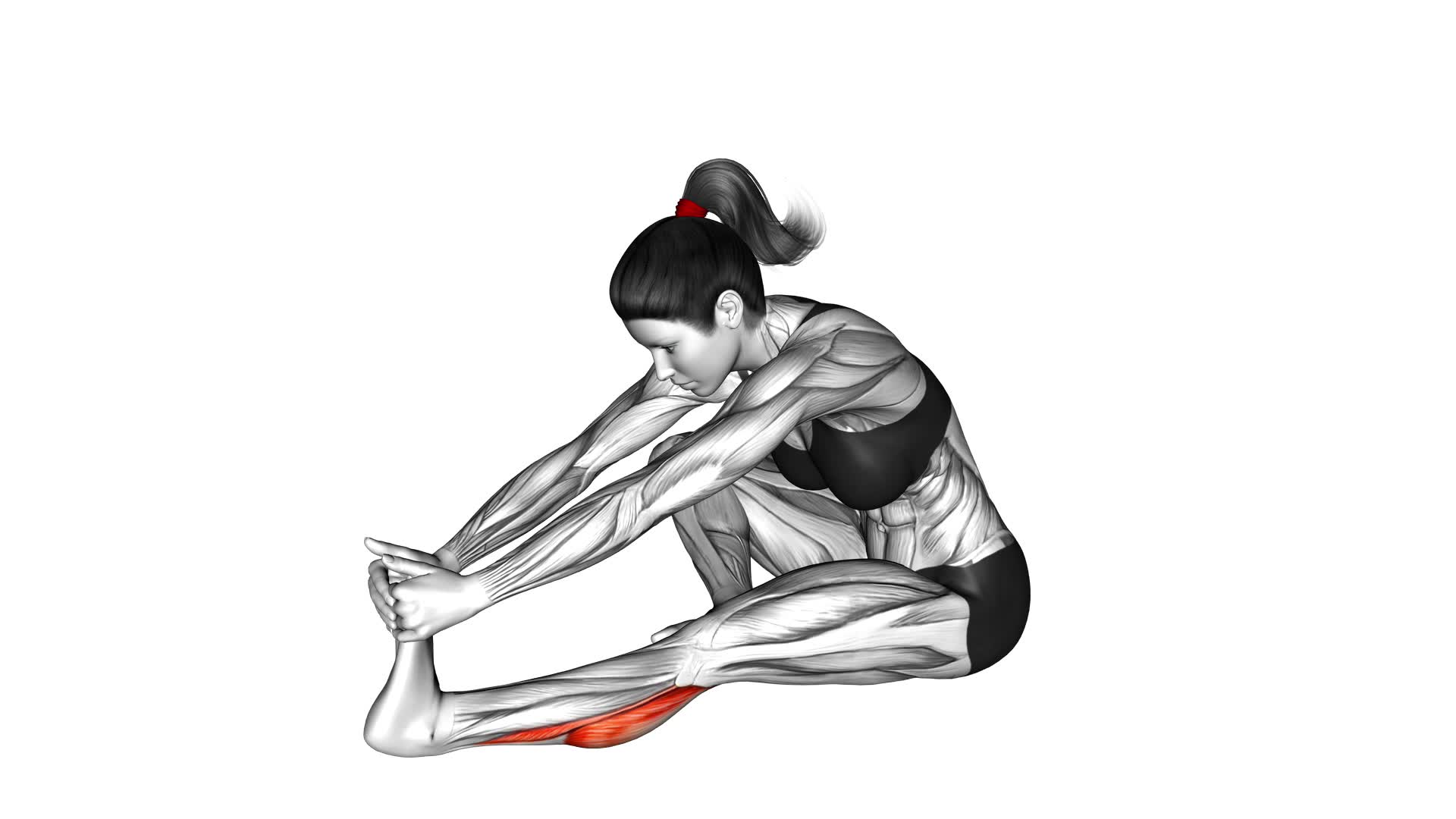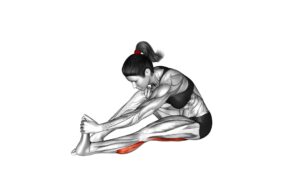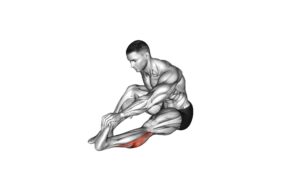Seated Calf Stretch (VERSION 2) – Video Exercise Guide & Tips

Looking to improve your calf flexibility and strength? Check out this video exercise guide for Seated Calf Stretch (Version 2).
Watch This Exercise Video
In just a few minutes, you'll learn the proper form, variations, and tips for a more effective stretch. Avoid common mistakes and get the most out of your calf stretch routine.
Get ready to feel the burn and see results with this simple yet effective exercise. Let's get started!
Key Takeaways
- Seated calf stretch improves flexibility and reduces tightness in calf muscles.
- Proper form includes sitting up straight with back against a chair or bench, extending one leg straight in front with heel on the ground, and leaning forward to feel the stretch in the back of the calf.
- Variations of seated calf stretch include standing calf stretch, seated calf raise, adjusting the intensity, and targeting different angles.
- To make the seated calf stretch more effective, maintain a straight back, flex the foot, gradually increase the intensity, and optimize the stretch for calf muscle flexibility and ankle mobility.
Benefits of Seated Calf Stretch
You can experience improved flexibility and reduced tightness in your calf muscles by incorporating the seated calf stretch into your routine. This stretch specifically targets the calf muscles, which can become tight and inflexible due to factors such as excessive sitting, high-impact activities, or wearing improper footwear.
By regularly performing the seated calf stretch, you can increase the flexibility of your calf muscles, allowing for better range of motion and preventing injuries.
Stretching the calf muscles also helps to reduce muscle tightness. When the calf muscles are tight, it can lead to discomfort and limited mobility. By stretching these muscles, you can alleviate tightness and improve overall muscle function. Additionally, stretching the calf muscles can also help to relieve tension and discomfort in other areas of the body, such as the lower back.
Incorporating the seated calf stretch into your routine is a simple and effective way to improve calf muscle flexibility and reduce muscle tightness. By taking just a few minutes each day to perform this stretch, you can experience the benefits of increased flexibility and reduced tightness in your calf muscles.
Now, let's move on to the next section to learn about the proper form for the seated calf stretch.
Proper Form for Seated Calf Stretch
To properly perform the seated calf stretch, position yourself on a chair or bench with your feet flat on the ground. This stretch is effective for targeting the calf muscles and improving flexibility.
Here are some key tips to ensure you're using the correct seated calf stretch technique:
- Sit up straight with your back against the chair or bench.
- Extend one leg straight in front of you, keeping your heel on the ground.
- Place your hands on your thigh or knee for support.
- Slowly lean forward, feeling a stretch in the back of your calf.
- Hold the stretch for 20-30 seconds, then relax.
- Repeat on the other leg.
Proper form is essential to maximize the benefits of the seated calf stretch. By keeping your back straight and your heel firmly on the ground, you can effectively target and stretch the calf muscles. This stretch can help improve flexibility, reduce muscle tightness, and alleviate discomfort in the lower legs.
Incorporating the seated calf stretch into your regular stretching routine can contribute to overall lower body flexibility and help prevent injuries.
Variations of Seated Calf Stretch
Exploring different variations of the seated calf stretch can enhance your stretching routine and target the calf muscles from various angles.
One variation to consider is the standing calf stretch. To perform this stretch, stand facing a wall with your hands on the wall for support. Step one foot back, keeping it straight and flat on the ground. Bend your front knee and lean towards the wall, feeling the stretch in your calf. Hold the stretch for about 30 seconds on each leg.
Another variation is the seated calf raise. This exercise not only stretches the calf muscles but also strengthens them. Sit on a chair or bench with your feet flat on the ground. Lift your heels off the floor as high as you can, contracting your calf muscles. Hold the raised position for a few seconds before lowering your heels back down. Repeat this movement for about 10-15 repetitions.
Incorporating these variations into your stretching routine can provide a well-rounded approach to calf stretching. The standing calf stretch targets the calf muscles differently than the seated calf stretch, while the seated calf raise adds a strengthening component to the stretch. Remember to listen to your body and adjust the intensity of the stretches as needed.
Tips for a More Effective Seated Calf Stretch
To maximize the effectiveness of your seated calf stretch, it's important to incorporate proper form and technique. Here are some tips to help you get the most out of this stretch:
- Maintain a straight back and engage your core muscles throughout the stretch. This will help to stabilize your body and prevent excessive strain on your lower back.
- Flex your foot and point your toes towards your body as you lean forward. This will target the calf muscles and increase the stretch.
- Gradually increase the intensity of the stretch by leaning forward slightly more with each repetition. This will help to improve calf muscle flexibility over time.
By following these tips, you can optimize the seated calf stretch to improve calf muscle flexibility and enhance ankle mobility. It's important to note that everyone's flexibility and mobility levels are different, so only stretch to a comfortable level without causing any pain or discomfort.
Now that you know how to perform the seated calf stretch effectively, let's discuss some precautions and common mistakes to avoid in the next section.
Precautions and Common Mistakes to Avoid
To avoid potential injuries and achieve optimal results, it's crucial that you take certain precautions and steer clear of common mistakes when performing the seated calf stretch.
First and foremost, make sure you're properly warmed up before attempting this stretch. Cold muscles are more prone to injury, so it's important to engage in a light cardio warm-up before starting.
Additionally, be mindful of your body's limitations and only stretch to a comfortable level. Pushing too hard or bouncing during the stretch can lead to muscle strains or tears.
Remember to breathe deeply and relax into the stretch, allowing your muscles to gradually release tension.
Another common mistake to avoid is neglecting proper form. Ensure that your back is straight and your core is engaged throughout the stretch.
Lastly, don't rush the stretch. Take your time and hold each stretch for at least 30 seconds to allow your muscles to fully elongate.
Frequently Asked Questions
How Often Should I Do the Seated Calf Stretch Exercise?
To get the most out of the seated calf stretch exercise, it's important to know how often to do it. The frequency of this exercise depends on your individual goals and fitness level. Generally, it's recommended to perform the seated calf stretch at least three times a week.
Holding the stretch for 30 seconds to a minute can help increase flexibility and improve muscle function. Incorporating this stretch into your regular routine can have numerous benefits for your calf muscles.
Can the Seated Calf Stretch Help With Shin Splints?
The seated calf stretch can be beneficial for shin splints. By stretching the calf muscles, it helps relieve tension in the lower leg, which can contribute to shin splints.
However, there are also alternative stretches that can help with shin splints, such as the standing calf stretch or the toe raise exercise.
It's important to find the stretch that works best for you and incorporate it into your routine to prevent and treat shin splints effectively.
Is It Normal to Feel Discomfort During the Seated Calf Stretch?
Feeling discomfort during the seated calf stretch is normal. It's a sign that your muscles are being stretched and worked. Although it may be uncomfortable, the stretch has numerous benefits.
It helps to improve flexibility, increase range of motion, and prevent muscle imbalances. Over time, the discomfort should decrease as your muscles become more flexible and accustomed to the stretch. Just remember to listen to your body and not push through any sharp or intense pain.
Can the Seated Calf Stretch Improve My Running Performance?
The seated calf stretch can definitely improve your running performance. By stretching your calf muscles, you can increase their flexibility, which can lead to improved endurance and prevent muscle imbalances.
When your calves are flexible, you'll have a greater range of motion and a more efficient stride while running. This can help you avoid overuse injuries and improve your overall running performance.
Are There Any Modifications for Individuals With Knee or Ankle Injuries?
If you have knee or ankle injuries, there are modifications you can make to the seated calf stretch. Instead of sitting on the floor, try sitting on a chair or bench. This will take pressure off your joints.
You can also try alternative exercises that don't put as much strain on your knees or ankles, such as standing calf raises or using a calf raise machine.
Remember to always listen to your body and consult with a healthcare professional before attempting any new exercises.
Conclusion
In conclusion, the seated calf stretch is a beneficial exercise for stretching and strengthening the calf muscles. By following proper form and incorporating variations, you can personalize the stretch to target different areas of the calf.
Remember to take precautions and avoid common mistakes to ensure a safe and effective stretch. With these tips, you can maximize the benefits of the seated calf stretch and improve your flexibility and muscle function.

Author
Years ago, the spark of my life’s passion ignited in my mind the moment I stepped into the local gym for the first time. The inaugural bead of perspiration, the initial endeavor, the very first surge of endorphins, and a sense of pride that washed over me post-workout marked the beginning of my deep-seated interest in strength sports, fitness, and sports nutrition. This very curiosity blossomed rapidly into a profound fascination, propelling me to earn a Master’s degree in Physical Education from the Academy of Physical Education in Krakow, followed by a Sports Manager diploma from the Jagiellonian University. My journey of growth led me to gain more specialized qualifications, such as being a certified personal trainer with a focus on sports dietetics, a lifeguard, and an instructor for wellness and corrective gymnastics. Theoretical knowledge paired seamlessly with practical experience, reinforcing my belief that the transformation of individuals under my guidance was also a reflection of my personal growth. This belief holds true even today. Each day, I strive to push the boundaries and explore new realms. These realms gently elevate me to greater heights. The unique combination of passion for my field and the continuous quest for growth fuels my drive to break new ground.







